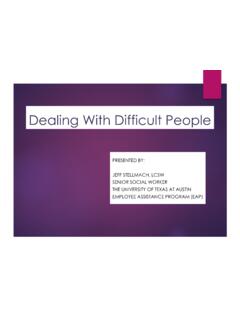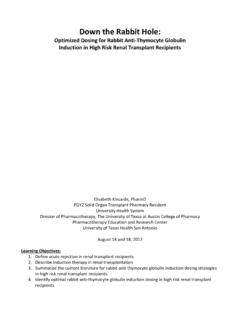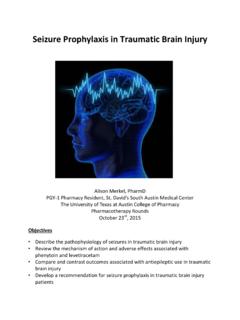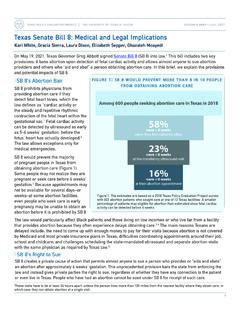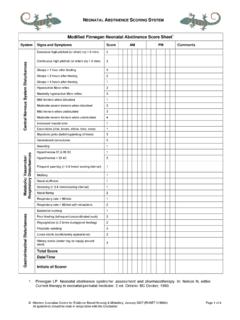Transcription of Clonidine for Opioid Related Neonatal Abstinence Syndrome ...
1 Clonidine for Opioid Related Neonatal Abstinence Syndrome : Is Clonidine the New Alpha-Male of Adjunct? Marc Flynt, PharmD Children s Hospital of San Antonio, San Antonio, TX Division of Pharmacotherapy, the University of Texas at Austin College of Pharmacy Pharmacotherapy Education and Research Center, University of Texas Health Science Center at San Antonio January 23, 2015 Learning Objectives Neonatal Abstinence the effects of withdrawal in a alternative adjunctive therapies for Neonatal Abstinence literature assessing the use of Clonidine in Neonatal Abstinence . 2M. Flynt 2015 Figure 1: Weighted national estimates of the rates of NAS per 1000 Hospital births per year2I. Background of Neonatal Abstinence Syndrome and epidemiologya. Clinical diagnosis resulting from abrupt discontinuation of chronic fetal exposure to substances used orabused by the mother during pregnancy.
2 In utero exposure through maternal withdrawal of medications used for sedation and has significantly increased of the last in NAS cases from to diagnoses per1000 live births from 2000 to 2009 in number of mothers using or dependent onopiates from to from 2000 to ,539 cases of NAS in one newborn with NAS 2013, about million American >12 years old used illicitsubstances in the past include non-medical use of illicit substances,which include LSD, PCP, peyote, mushrooms, ecstasy,marijuana, cocaine, heroin, stimulants, and of pregnant women were current users of illicit drugs in the number of NAS cases has increased so has the expenditure increased from $190 million to $720 million from 2000 to average length of stay has not fluctuated with the average still around 16 ,4, has a higher cost per stay at an average of $53,400 in 2009 compared to $9,500 for non-NAS 2: Average hospital charge and length of stay for Neonatal Abstinence Syndrome vs all other US births2 Table 1: Admissions > 12 years old according to primary substance of abuse 201233 3M.
3 Flynt 2015 Exposure Maternal use of opiates Passive exposure Dependence Chronic exposure Development of dependence Birth Abrupt discontinuation Development of symptoms 3. History of NAS Pathophysiology a. Effects of acute opiate use on neurotransmitters1 i. Increased dopamine6 ii. Increased serotonin iii. Decrease in GABA iv. Decrease in norepinephrine v. Decrease corticotropin-releasing hormone7 b. Mechanism of withdrawal8 i. Acute exposure decreases cAMP and neurotransmitter production ii. Body compensates with chronic use and increases production iii. Discontinuation causes increase in cAMP and neurotransmitter production c. Opiates crossing the placenta9 i. Small molecular weight ii. Less protein binding iii. Lipophilic iv. P-gp efflux pumps begin decreasing at 35 weeks gestation 1.
4 Slower removal of drug 2. Exposure later in pregnancy leads to increased fetal exposure10 d. Prolonged half-life (T ) of opiates in the fetus11 i. Morphine 1. T = 9 hours in premature neonates 2. T = hours in term neonates ii. Methadone 1. T = hours in neonates iii. Heroin 1. T = 30 minutes 2. Active metabolite 6-monoacetylmorphine further converted to morphine e. Prognosis of neonates with intrauterine exposure i. Increase in psychomotor and neurologic abnormalities at one year of age12 1. Decrease in locomotor and intellectual development 1971: Methadone withdrawal in five neonates 1892: Series of 12 infants with Neonatal withdrawal which led to nine deaths. Trial of paregoric. 1903: Morphine treatment for neonates reported 1875: First reported case of Neonatal withdrawal 1853: Hypodermic needle developed 1874: Heroin synthesized 1898: Commercial production 1804: Morphine isolated 1817: Marketed as analgesic 1827: Commercial production 1937: Methadone developed 1800 1830 1860 1890 1920 1950 1980 Figure 2: Timeline of opiates and NAS1 Figure 3: Steps to withdrawal 4M.
5 Flynt 2015 II. Clinical Presentation 1. Signs and symptoms a. Symptom onset depends on: i. Last in-utero exposure ii. Substance used in-utero iii. Gestational age iv. Maternal use of multiple substances b. Typical time to withdrawal symptom onset1 i. Heroin within first 24-48 hours ii. Methadone 48-72 hours iii. Prescription opioids 36-72 hours c. Symptoms13 i. Neurologic ii. Gastrointestinal iii. Autonomic d. If left untreated there is an increased risk of sudden infant death Syndrome (SIDS)14 2. Diagnosis15 a. Diagnosis is based on two major factors i. Maternal history ii. Neonatal signs and symptoms b. Testing (see appendix page A7) i. Maternal drug screen ii. Newborn urine screen iii. Meconium analysis c. Testing should be performed if: i. Mother self-reports use of substances ii.
6 Mother has a known history iii. Signs are present and history is unknown 3. Assessment16 a. Tools we have for assessing and guiding therapy (see appendix page A4) i. Original Finnegan Scale (see appendix page A5) 1. 31 item list evaluating symptoms and severity 2. Comprehensive list evaluating multiple symptoms 3. Takes more time to complete but more inclusive ii. Lipsitz Neonatal Drug-Withdrawal Scoring System 1. 11 item scale with scoring ranging from 0-3 based on severity 2. Easily administered but contains subjective areas 3. Not as comprehensive 4. No longer recommended for scoring iii. Modified Finnegan Scale 1. 21 item list similar to the Finnegan scale 2. Decreased from 31 due to redundancies in the previous version 3. Most commonly used and widely accepted scoring system 4.
7 Gold standard Figure 4: Mechanism of Opioid withdrawal in neonates1 5M. Flynt 2015 III. Management 1. Goals17 a. Ensure safe and comfortable withdrawal b. Maintain appropriate nutritional intake c. Ensure appropriate fluid status d. Ensure appropriate adaptation to the environment e. Prevent complications 2. Guideline Recommendations a. Overview1,18-20 i. Non-pharmacologic 1. Shown effective in managing mild cases (MFS < 8) 2. Should be used at every stage of therapy ii. First line pharmacologic 1. Opiate replacement with morphine iii. Adjunctive with non- Opioid treatment 1. Phenobarbital 2. Clonidine b. Ontario guidelines18 i. Assess using MFS ii. Non-pharmacologic options are first line iii. Initiate oral morphine if MFS > 8 1. Titrate dose to maintain scores < 8 iv.
8 Consider Clonidine if morphine dose reaches 1mg/kg/day c. Australian guidelines 20 i. First determine risk and begin scoring ii. Begin non-pharmacologic measures iii. Opiate dependent mothers? 1. Yes morphine 2. No Phenobarbital iv. Start phenobarbital as adjunctive if morphine dose of 1mg/kg/day is reached. d. American Academy of Pediatrics1 i. Determine risk of NAS and begin scoring if they are at risk ii. Start non-pharmacologic treatment iii. Only exposed to opiates? 1. Yes morphine 2. No phenobarbital iv. Augment with phenobarbital or Clonidine if dose of mg/kg/day of morphine needed 3. Non-Pharmacologic15,19 a. Swaddling b. Rocking c. Maintain extremities at midline d. Pacifiers e. Decreasing external stimuli f. Maintain temperature stability 4.
9 First Line Pharmacologic Therapy (see appendix page A6) a. Oral morphine is the preferred agent1,13,18,21-25 i. Shorter duration of action when compared with methadone ii. Less alcohol content compared to diluted tincture of opium 6M. Flynt 2015 b. Methadone i. An option but less preferred than morphine ii. Long half-life with difficult titration c. Buprenorphine 15 i. Lack of evidence to support use in neonates 5. Adjunctive Therapy15,24,25 a. Clonidine i. Mechanism 1. Alpha-2 agonist that works at the presynaptic terminals in the medulla causing an inhibition of sympathetic outflow. ii. Effects on NAS 1. Inhibition of sympathetic outflow decrease epinephrine and norepinephrine 2. Decreases autonomic symptoms such as: 1) Tachycardia 2) Agitation 3) Hypertension 4) Sweating iii.
10 Pharmacokinetics 1. Absorption = 75-90% 2. Protein binding = 20-40% 3. Half-life = 44-72 hours26 1) Increased due to decreased clearance and metabolism27 iv. Common side effects 1. Hypotension 2. Bradycardia 3. Rebound hypotension with abrupt discontinuations b. Phenobarbital i. Mechanism 1. Augments receptors and promotes binding of GABA to cause CNS depression ii. Effects in NAS 1. Causes decreased excitability iii. Pharmacokinetics 1. Absorption= 70-90% 2. Half-life = 45-100 hours iv. Common side effects 1. Sedation 2. Bradycardia 3. Hyperactivity v. Long term side effects 1. Decreased cognitive performance that lasted years following discontinuation28 7M. Flynt 2015 IV. Literature Evaluation Agthe AG, Kim GR, Mathias KB. Pediatrics. 2009; 123(5).
